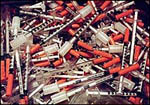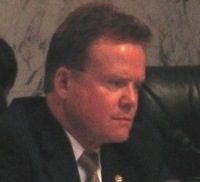As 2009 prepares to become history, we look back at the past year's domestic drug policy developments. With the arrival of a highly popular (at least at first) new president, Barack Obama, and Democratic Party control of the levers of power in Congress, the drug reform gridlock that characterized the Bush years is giving way to real change in Washington, albeit not nearly quickly enough. A number of this year's Top 10 domestic drug stories have to do with the new atmospherics in Washington, where they have led, and where they might lead.
But not all of them. Drug reform isn't made just in Washington. Under our federal system, the 50 states and the District of Columbia have at least some ability to set their own courses on drug policy reforms. In some areas, actions in the state legislatures have reflected trends -- for better or worse -- broad enough to earn Top 10 status.
And Washington and the various statehouses notwithstanding, movement on drug reform is not limited to the political class. Legions of activists now in at least their second decade of serious reform work, a mass media that seems to have awakened from its dogmatic slumber about marijuana, a crumbling economy, and a bloody drug war within earshot of the southwestern border have all impacted the national conversation about drug reform and are all pushing politicians from city councilmen to state legislators to US senators to rethink drug prohibition.
For drug reformers, these are interesting times, indeed. Herewith, the Top 10 domestic drug policy stories of 2009:

Wow. This year has seen the US enter the beginnings of a sea change on policies and attitudes toward the recreational use of marijuana. The first hint that something had changed was the Michael Phelps bong photo non-scandal. When the multiple Olympic gold medal winner got outed for partying like a college student, only one corporate sponsor, fuddy-duddy Kellogg, dumped him, and was hit by a consumer boycott -- and arguably by falling stock prices -- in return. Otherwise, except for a deranged local sheriff who tried fruitlessly to concoct a criminal case against somebody -- anybody! -- over the bong photo, America's collective response basically amounted to "So what?"
Post-Phelps it was as if the flood gates had opened. Where once Drug War Chronicle and a handful of other publications pretty much had the field to ourselves, early this year, the mass media began paying attention. Countless commentaries, editorials and op-eds have graced the pages of newspaper and those short-attention-span segments on the cable news networks, an increasing number of them calling for legalization. The conversation about freeing the weed has gone mainstream.
The sea change is also reflected in poll numbers that, for the first time, this year showed national majorities in favor of legalization. In February, a Zogby poll showed 44% support nationwide -- and 58% in California. By late spring, the figures were generally creeping ever higher. An April Rasmussen poll had support for "taxation and regulation" at 41%, while an ABC News/Washington Post poll found 46% supported "legalizing the possession of small amounts of marijuana for personal use." Also in April, for the first time, a national poll showed majority support for legalization when Zogby showed 52% saying marijuana should be "legal, taxed, and regulated." In July, a CBS News poll had support for legalization at 41%.
In October, a Gallup poll had support for legalization at 44%, the highest ever in a Gallup survey. And a few weeks ago an Angus-Reid poll reported 53% nationwide supported legalization. Legalizing pot may not have clear majority support just yet, but it is on the cusp.
Marijuana law reform was also a topic at statehouses around the country this year, although successes were few and far between. At least six states saw decriminalization bills, but only one passed -- in Maine, which had already decriminalized possession of up to 1.25 ounces. This year's legislation doubled that amount. And then there were legalization bills. Two were introduced in the 2009 session, in California and Massachusetts, and two more have been pre-filed for next year, in New Hampshire and Washington. Both the California and Massachusetts bills got hearings this year, and the California bill is set for another hearing and a first committee vote in the Assembly in two weeks. In Rhode Island, meanwhile, the legislature voted this year to create a commission to study marijuana law reform; it will report at the end of January.
And then, finally, there is the excitement and discussion being generated by at least three separate marijuana legalization initiative campaigns underway in California. Oaksterdam medical marijuana entrepreneur Richard Lee's Tax Cannabis 2010 initiative has already announced it has sufficient signatures to make the ballot. Time will tell if the others make it, but at this point it is almost certain that voters in California will have a chance to say "legalize it" in November.

During his election campaign, President Obama promised to quit siccing the DEA on medical marijuana patients and providers. In February, new Attorney General Eric Holder announced there would be no more federal raids if providers were in compliance with state law, and pretty much held to that promise since then. In October, the Justice Department made it official policy when it issued a policy memo reiterating the administration's stance.
The new "hands off" policy from Washington has not been universally adhered to, nor has it addressed the issue of people currently serving sentences or facing prosecution under Bush administration anti-medical marijuana initiatives, but it has removed a huge looming threat to growers and dispensary operators and it has disarmed a favored (if intensely hypocritical) argument of medical marijuana foes that such laws should not be passed out of fear of what the feds would do.
Meanwhile, California rolls right along as medical marijuana's Wild West. Like countless other localities in the Golden State, the city of Los Angeles is grappling with what to do with its nearly one thousand dispensaries. The issue is being fought city by city and county by county, in the state courts and in the federal courts. And while the politicians argue, dispensary operators are creating political facts on the ground as their tax revenues go into hungry state and local coffers.
This year also marked the emergence of a medical marijuana industry infrastructure -- growers, grow shops, dispensaries, educational facilities, pot docs -- beyond California's borders, most notably in Colorado, where the dispensary scene exploded in the wake of the removal of the federal threat, and in Michigan, where last year's passage of a medical marijuana law has seen the creation of the Midwest's first medical marijuana industry.
While medical marijuana is legal in 13 states (and now, the District of Columbia), it remains difficult to win victories in state legislatures. There were medical marijuana bills in at least 18 states, but only two -- Minnesota and New Hampshire -- were approved by legislatures, and they were vetoed by prohibitionist governors. Bills are, however, still alive in six states -- Delaware, Illinois, New Jersey, New York, Pennsylvania, and Wisconsin -- with New Jersey and Wisconsin apparently best positioned to become the next medical marijuana state. In Rhode Island, which already approved a medical marijuana law in 2007, the legislature this year amended it to include a dispensary system.

Despite evident progress on some drug reform fronts, a substantial number of Americans continue to hold to prohibitionist values, including a number of state legislators. The legislative response to the popularity of the fast-acting, short-lived hallucinogen salvia divinorum is the best indicator of that.
The DEA has been reviewing salvia for five years, and has yet to determine that it needs to become a controlled substance, but that hasn't stopped some legislators from trying to ban it. Appalled by YouTube videos that show young people getting very high, legislators in 13 states have banned or limited sales of the herb.
This year, four more states joined the list. The good news is that legislators in seven other states where salvia ban bills were introduced had better things to do with their time than worry about passing them.

In another indication that the drug warrior impulse is still alive and well -- as are its class war elements -- legislators in various states this year continued to introduce bills that would mandate suspicionless drug testing of people seeking unemployment, public assistance, or other public benefits. Never mind that Michigan, the only state to pass such a law, saw its efforts thrown out as an unconstitutional search by a federal appeals court several years back.
Such efforts exposed not only public resentment of benefits recipients, but also a certain level of ignorance about the way our society works. A common refrain from supporters was along the lines of "I have to get drug tested for my job, so why shouldn't they have to get drug tested?" Such questioners fail to understand that our system protects us from our government, but not from private employers.
But if welfare drug testing excited some popular support, it also excited opposition, not only on constitutional grounds, but on grounds of cost and elemental fairness. In the four states where drug testing bills were introduced -- Kansas, Louisiana, Missouri and West Virginia -- none of them went anywhere. But even in an era when drug reform is in the air, such bills are a clear sign that there will be many rear-guard battles to fight.

Reeling under the impact of economic downtowns and budget crises, more and more states this year took a second look at drug-related sentencing policies. Most notable of the reforms enacted at the state level this year were reforms in New York's draconian Rockefeller drug laws, which went into effect in October. Under this newest round of Rockefeller drug law reforms, some 1,500 low-level drug offenders will be able to seek sentence reductions, while judges gain some sentencing power from prosecutors, and treatment resources are being beefed up. But still, more than 12,000 will remain in Empire State prisons on Rockefeller drug charges.
New York wasn't the only state to enact sentencing reforms this year. This month, New Jersey legislators passed a bill giving judges the discretion to waive mandatory minimum sentences for some drug offenses. Last month, Rhode Island mandatory minimum reforms went into effect. Earlier this year, Louisiana finally acted to redress the cruel plight of the "heroin lifers," people who had been sentenced to life without parole for heroin possession under an old state law. A new state law cut heroin sentences, but did not address the lifers. As a result, some lifers remained in prison with no hope of parole while more recent heroin offenders came, did their time, and went. Now, under this year's law, the lifers are eligible for parole.
Sentencing reforms are also in the works in a number of other states, from Alabama to California and from Colorado to Michigan. In some cases, reform legislation is in progress; in others, legislators are waiting for commissions to report their findings. In nearly every case, it is bottom-line budget concerns rather than bleeding heart compassion for the incarcerated that is driving the reforms.

It was only one bill in one state, and all it required was reporting by SWAT teams of their activities, but the Maryland SWAT bill passed this year marked the first time a state legislature has moved to rein in aggressive paramilitary-style policing. More precisely, the bill requires all law enforcement agencies that operate SWAT teams to submit monthly reports on their activities, including when and where they are used, and whether the operations result in arrests, seizures or injuries.
In took an ugly incident involving the mayor of a Washington, DC, suburb to make it happen. Marijuana traffickers sent a load of pot to the mayor's address to avoid having police show up on their doorstep in the event something went wrong, but something did go wrong, and police tracked the package. When the mayor innocently carried the package inside on returning home, the SWAT team swooped, manhandling the mayor and his mother-in-law and killing the family's pet dogs. The cops were unapologetic, the mayor was apoplectic, and now Maryland has a SWAT law. A new bill just filed in Maryland would take it further, requiring police to secure a judge's warrant before deploying a SWAT team.

While Congress and the Bush administration got serious about Mexico's bloody drug wars in 2008, passing a three-year, $1.4 billion anti-drug aid package for Mexico and Central America, it was not until this year that the prohibition-related violence in Mexico really made the radar north of the border.
It only took about 11,000 deaths (now up to over 16,000) among Mexican drug traffickers, police, soldiers, and innocent bystanders to get the US to pay attention to the havoc being wreaked on the other side of the Rio Grande. But by the spring, Washington was paying attention, and for the first time, one could hear mea culpas coming from the American side. Mexico's drug violence is driven by demand in the US, Secretary of State Hillary Clinton admitted and Homeland Security Secretary Janet Napolitano echoed.
But just because Washington admitted some fault didn't mean it was prepared to try anything different. And while the Mexican drug wars brought talk of legalization -- especially of marijuana -- what they brought in terms of policy was the Southwest Border Counternarcotics Strategy, which is basically mo' better drug war.
Mexico's drug wars show no signs of abating, and the pace of killing has accelerated each year since President Felipe Calderon sent in the army three years ago this month. The success -- or failure -- of his drug war policies may determine Calderon's political future, but it has for the first time concentrated the minds of US policymakers on the consequences of prohibition south of the border.

After a decade-long struggle, the ban on federal funding for needle exchange programs ended this month with President Obama's signature on an omnibus appropriations bill that included ending the federal ban, as well as a similar ban that applied to the District of Columbia. The bill also removed a ban on the District implementing a medical marijuana law passed by voters in 1998.
Removing the funding ban has been a major goal of harm reduction and public health coalitions, but they had gotten nowhere in the Republican-controlled Congresses of the past decade. What a difference a change of parties makes.

The US Congress has been a solid redoubt of prohibitionist sentiment for decades, but this year saw the beginning of cracks in the wall. Two legislators, Rep. Elliot Engel (D-NY) and Sen. Jim Webb (D-VA) introduced and have had hearings on bills that could potentially challenge drug war orthodoxy.
Engel's bill, the Western Hemisphere Drug Policy Commission Act, which has already passed the House, would set up a commission to examine US eradication, interdiction, and other policies in the Western Hemisphere. While Engel is no anti-prohibitionist, any honest commission assessing US drug policy in the Americas is likely to come up with findings that subvert drug war orthodoxy.
Meanwhile, Sen. Webb's National Criminal Justice Commission Act of 2009 comes at the issue from a much more critical perspective. It calls for a top-to-bottom review of a broad range of criminal justice issues, ranging from sentencing to drug laws to gangs and beyond, with an emphasis and costs and efficacy. Webb's bill remains in the Senate Judiciary Committee, but has 35 cosponsors. Webb has already held hearings on the costs of mass incarceration and the economic costs of drug policy, and even more than Engel's bill, the Webb bill has the potential to get at the roots of our flawed national drug policy.

The 100:1 disparity in the quantities of crack needed to earn a mandatory minimum federal prison sentence versus the quantities of powder cocaine needed to earn the same sentence has been egregiously racist in its application, with roughly 90% of all federal crack offenders being non-white, and pressure has been mounting for years to undo it. It hasn't happened yet, but 2009 finally saw some serious progress on the issue.
The move to reform the sentencing disparity got a boost in June, when Attorney General Holder said it had to go. The next month, a House Judiciary Committee subcommittee passed the Fairness in Cocaine Sentencing Act of 2009. The bill is now before the House Judiciary and Energy and Commerce Committees.
On the Senate side, Sen. Dick Durbin (D-IL) introduced a companion bill in October, the Fairness in Sentencing Act. It hasn't moved yet, but thanks to a decade-long effort by a broad range of advocates, all the pieces are now in place for something to happen in this Congress. By the time we get around to the Top 10 of 2010, the end of the crack/powder cocaine sentencing disparity better be one of the big stories.
Comments
Salvia Harmless??? Yeah, right..
Still subscribing to the idea that salvia is harmless. Get your head out of your butt and read this:
Persistent Psychosis Associated With Salvia
Divinorum Use
Salvia divinorum (salvia) is a sage plant that
is easily obtained in the United States. Its active ingredient,
Salvinorin A, is a novel and highly selective pure kappa opiate
receptor agonist with rapid onset and powerful hallucinogenic
properties (1). Salvia has become increasingly popular
as a drug of abuse when smoked. No long-term negative outcomes
have been reported from the use of salvia. We present
a case in which salvia precipitated persistent psychosis.
âMr. Jâ was a 21-year-old man with no family or personal
psychiatric history or laboratory abnormalities. He
was reported to have normal social interactions, behavior,
and cognitive skills. He was transferred to our psychiatric
unit for acute psychosis and paranoia, which occurred
shortly after smoking salvia. In transport, the patient became
suspicious and attempted to jump from the vehicle.
Upon presentation, he demonstrated echolalia, paranoia,
flight of ideas, and psychomotor agitation. The patient remained
agitated for the first 2 days of hospitalization. He
attempted to barricade himself in his room. Risperidone
(3 mg by mouth/three times per day) was administered,
and the patient was eventually stabilized. The dosage,
however, resulted in the parkisonian features of rigidity,
bradykinesia, and masked facies.
Mr. J was transferred to the chemical dependency unit
for further treatment. He was stabilized, and treatment
with risperidone was slowly tapered. During the taper
from risperidone, the patient continued to improve and
manifested better insight and logical thought processes.
He participated in group therapy and interacted with
peers, and the parkinsonian features subsided. One day
after risperidone was withdrawn, the patientâs symptoms
abruptly returned. He became agitated, paranoid, and aggressive
and believed he was able to project and receive
thoughts. He returned to the inpatient psychiatry unit
where risperidone (3 mg by mouth/twice daily) was reinstated.
He was once again stabilized and transferred to
the referring psychiatric facility for further treatment. At
the 4-month follow-up, the patient exhibited no perceptible
improvement.
To the best of our knowledge, this is the first reported case
of a persistent negative outcome from the use of salvia. We
suspect that our patient was genetically predisposed to
schizophrenia, and salvia precipitated the clinical manifestations.
This may relate to the drugâs ability to influence dopamine
levels in the brain and potentiate plastic changes in
frontal lobe networks (3).
Previous studies have cited salvia as a potential treatment
option for CNS illnesses (2). This is surprising, considering the
paucity of research regarding its efficacy. Salviaâs ability to increase
dopamine levels in the nucleus accumbens increases
its potential for dependence. Consistently, patients at our
clinic who have used the drug report that its psychological effects
are abrupt and frightening. Clinicians should be aware
that salvia use can be associated with psychiatric illness.
References
1. Prisinzano T: Psychopharmacology of the hallucinogenic sage
Salvia divinorum. Life Sci 2005; 78:527â531
2
In reply to Salvia Harmless??? Yeah, right.. by Freakazoid (not verified)
"To the best of our
"To the best of our knowledge, this is the first reported case
of a persistent negative outcome from the use of salvia."
First reported case.
"Previous studies have cited salvia as a potential treatment
option for CNS illnesses"
Sounds like more benefit than harm.
just my two cents; never really cared for the experience myself
Psilo has been a much kinder teacher in my humble opinion.
In reply to Salvia Harmless??? Yeah, right.. by Freakazoid (not verified)
Did the man have any other
Did the man have any other mental problems besides schizophrenia before taking the herb? Do you have any other recorded cases, besides this one which the patient was mistreated and wrongly diagnosed?
working hard in Wisconsin
Thanks for the mention about the medical marijuana bill currently awaiting a vote by the WI State Legislature. At a recent public hearing we had 105 in favor and only 5 against. We have a Democratic controlled Assembly and Senate. When first introduced the bill had something like 35 Assembly co-sponsors and 2 Senate co-sponsors. And unlike some other states that have come close to passing a bill, like our fine neighbors in MN, WI Gov. Doyle has promised to sign our bill if it reaches his desk.
So if you live in WI or know anyone that does, please encourage them to contact their Assembly and Senate reps and demand they support the JRMMA (Jacki Rickert Medical Marijuana Act).
Madison Norml
Madison, WI
Salvia Dangerous???? Where were the facts?
Salvia is a hallucinogen. With pretty much every psychotropic drug in the world there is the risk that the use of the drug will precipitate the onset of a genetic mood or mental disorder. Most major mood disorders seem to come on suddenly and specifically between the ages of 21-25. Although the article made a convincing case that "Mr. J" probably should stay away from hallucinogenic drugs it in no way gave any factual evidence to support Salvia being the cause (and not just a trigger) of the problem. People who are predisposed to disorders such as Schizophrenia or Bipolar almost always have a similar experience. I take Risperidone as well, every day but my "break" where I ended up in the hospital was due to being overstressed the week before finals. According to your logic the government should make college illegal too.
BTW... how you gonna have the 'Hutzpa to post the authors name and sign yours as anonymous?
my name for the record
is Caleb Calhoun and I live in Chattanooga, TN and I will not let fear and misconception take away my right to speak out for the end of prohibition.
Salvia 1 (man in Delaware); Nicotiana (last decade) 50,000,000
Having read the story by the "Harmless??? Yeah, right... get your head out of your butt" guy, here are my observations:
1. "He was transferred to our psychiatric unit... became suspicious and attempted to jump from the vehicle." Sounds like some dissident in Iran fearing detention, torture and death.
2. "Rispiridone (3 mg per mouth/three times per day) was administered, and the patient was eventually stabilized. The dosage, however, resulting in the parkinsonian features of rigidity, bradykinesia and masked facies." Now we know why he violated protocol and tried to escape: he feared they would inflict parkinsonian features of rigidity, bradykinesia and masked facies upon him before he was eventually stalinized, oops sorry stabilized.
3. " One day after risperidone was withdrawn, the patientâs symptoms abruptly returned." Great, now they have him hooked on an addictive drug, with withdrawal symptoms if dosage stops.
4. "He became agitated, paranoid, and aggressive and believed he was able to project and receive thoughts." I thought everybody believed that, here we have all these technologies of speech, gesture, textmessaging etc. to take care of it.
5. "He was once again stabilized and transferred to the referring psychiatric facility for further treatment. At the 4-month follow-up, the patient exhibited no perceptible improvement." Notice, they do a lot of "stabilizing"-- the writer uses that term three times. The four months detention-- probably at daily rates somewhere between a prison and a nursing home?-- seem to serve the purpose of transferring money out of taxpayer pocket into the budgets of these technocratic detention facilities, evidently thought to protect the public from raving aggressive paranoids (RAP).
6. I wonder if "patients" (prisoners) like this man are included in the over-2,000,000 statistic of "incarceration" which disgraces the United States of America worldwide-- along with the yearly Nicotiana tabacum $igarette death rate: US 440,000, world 5.4 million; US 4.5% of world pop., 8.2% of world $igarette death$. Oh yes, one guy died of Salvia demonorum in Delaware.
In reply to Salvia 1 (man in Delaware); Nicotiana (last decade) 50,000,000 by maxwood (not verified)
He didn't die, dude.
He didn't die, dude.
One man --
ONE MAN becomes agitated and paranoid after using salvia. So here's what let's do. Let's ban salvia. Let's send heavily-armed, riot-geared ski-masked SWAT teams to invade the homes of suspected salvia users. Whenever possible, make the invasions in the middle of the night, when people are most likely to be sleepy and disoriented (the better to terrorize them) and children are most likely to home (the better to terrorize them and charge parents with child abuse). Take or destroy everything these losers hold dear, including their families, their homes and their livelihoods. After all, we sure don't want people to become agitated or paranoid, do we?
In reply to One man -- by rita (not verified)
!!!!!!
That is a high alert on the sarcasm meter. WOW!
Millions of people have
Millions of people have smoked salvia. One guy had this reaction. Would it be unreasonable to suspect that something unusual happened here and that maybe we don't have all the information? Maybe the salvia was spiked with something, for example?
Add new comment